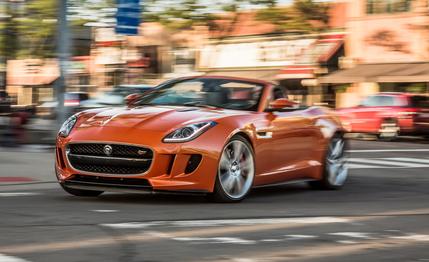
 Long-Term Road Test Wrap-Up
From the August 2015 issue
Long-Term Road Test Wrap-Up
From the August 2015 issue
Sales are not always the ultimate arbiter of a brand’s outlook, at least not in the same way that failure is a certainty in their absence. Jaguar’s numbers, in free fall when Ford dumped the brand in early 2008 on India’s Tata Motors, seem to have plateaued. It sold 15,773 cars in the U.S. in 2014, just 90 more than during Dearborn’s final full year of ownership. Luxury-segment leader Mercedes-Benz did about 23 times Jaguar’s volume last year; Porsche moved as many Cayennes as Jaguar did of its entire product line. Yet there is reason for optimism in Coventry. With the XE sedan coming next year and the F-Pace crossover also on the way, Jaguar’s sales trajectory can only be pointed upward.
Our esteem, however, is less informed by popularity than it is by personality and performance. When we road-tested the Jaguar F-type in 2013, we drank in its siren song, an astoundingly brazen exhaust note that simply cannot be ignored. Even if this fearsome-faced roadster resembled a UPS truck (which, thankfully, it doesn’t in the slightest), at full boil it would turn heads. So, of course, we had to order one for a long-term test, already knowing that given Jaguar’s reputation, there could be a shipwrecked-on-the-rocks, flesh-rotting-from-your-bones end to this mission.
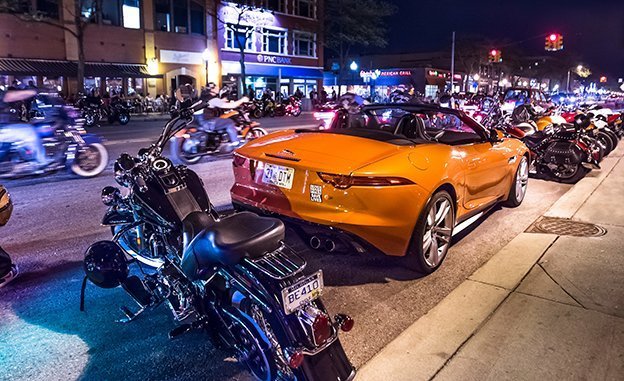

The last two Jaguars to survive 40,000 miles under our care were criticized for various “gremlins” and “quirks,” but that did not keep us from tempting the fates by ticking many, many boxes on the order sheet. We added $8825 in options to the $92,895 base price of the V-8 S, bringing the bottom line of our Firesand Orange ($600) F-type up to $101,720.
Spending $2950 for the Performance Pack got us the Switchable Active Exhaust and other racy equipment, such as sport seats, a flat-bottomed steering wheel, red brake calipers, and a toggle switch on the console to select dynamic or winter drive mode. Other add-ons included seat and steering-wheel heaters ($600), satellite and HD digital radio ($450), a wind deflector ($200), and a package that included a parking camera, blind-spot monitoring, and adaptive headlights that turn during cornering ($2100).
Some staffers would later think better of having chosen the top-of-the-line, 495-hp V-8 model, instead feeling that we should have sampled the better-selling V-6 S. Nor were we aware that Jaguar would overhaul the F-type range so that a rear-drive V-8 S such as our long-termer is no longer available. Starting with the 2016 model year, all V-8 F-types are 550-hp R models with four-wheel drive. The 380-hp V-6 S, however, can still be had as a tail-happy rear-driver. And for the first time, that latter F-type will offer a six-speed manual for those who, like us, wish to do their own shifting. That we’re eager to put one of these new F-types through the wringer is proof of the positive impression our long-termer made.
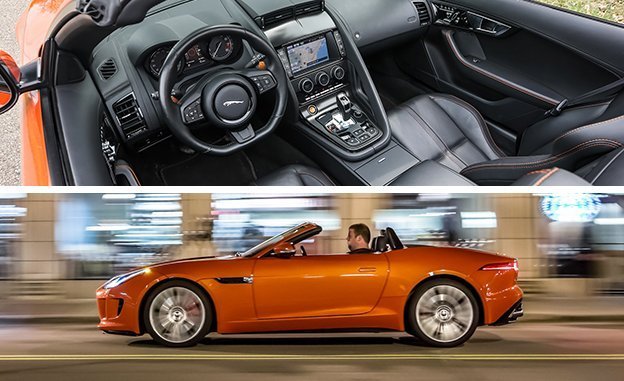
 The only thing slow about the F-type is its nav system.
The only thing slow about the F-type is its nav system.
Our logbook is full of raves about the F-type’s looks, the prodigious power of its supercharged engine, and its locked-down handling. But tearing through the quarter-mile in 11.9 seconds and pulling 0.97 g on the skidpad at the end of our test was expected behavior. More surprising was the F-type’s performance during cold weather, when it delivered safe transport thanks to an effective winter-driving mode. We only wish we had ordered better winter tires than the recommended Pirelli Sottozeros, which seemed less capable than other rubber we fitted to comparable high-horsepower vehicles this past winter. But nothing about our F-type drained more ballpoints than the way it sounded—like an orchestra whose strings, brass, woodwinds, and percussion have been replaced by shotguns, chain saws, fireworks, and hand grenades. The Jag’s active exhaust is clearly engineered to drown out the wail of Porsche flat-sixes and overpower the low rumble of naturally aspirated Chevrolet Corvette V-8s. You have some control over this fury via the little button with a tailpipe icon on the center console, which, when pushed, causes the exhaust flaps to open early. But merely getting on the gas good and hard discharges the same roar. Lifting the throttle brings forth more snaps, crackles, and pops than a Kellogg’s factory.
How loud is it? Holding the sound-level meter during final testing, it occurred to us that we should have made this measurement before we put 40,000 miles on the car. But then there would have been meetings with human resources about OSHA violations because, with the sound meter 50 feet away from this Jag, we recorded 95 dBA during its acceleration. That’s as loud as a jackhammer, well past the 85-dBA threshold where repeated exposure causes hearing damage. Even inside the car, with the windows up and the top closed, we measured 89 dBA at wide-open throttle.
Loud pipes are hardly new phenomena, but we’ve noticed a recent proliferation of factory-fitted systems that goose the sound at the driver’s command. A current Porsche Boxster S registered 91 dBA from the driver’s seat, and we recorded 92 dBA in the new Corvette Z06 convertible. You would think these trick mufflers must run afoul of noise laws somewhere, yet Jaguar assures us that the F-type is fully compliant with local market regulations, as well as the latest revision of the United Nations Economic Commission for Europe Regulation 51, which concerns noise emissions. It would take a team of lawyers and engineers to fully decipher that document, which describes a testing procedure similar to ours only in its use of the word “testing.” If the F-type is what all cars would sound like under global U.N. rule, we’d welcome the black helicopters here at 1585 Eisenhower Place.
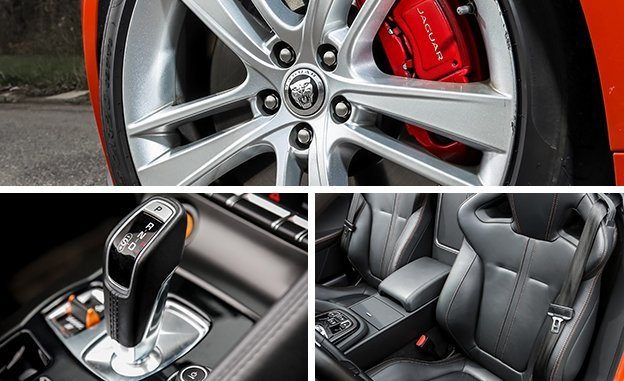
 Top: Budget plenty of money for replacement tires.
Top: Budget plenty of money for replacement tires.
Not all our time spent with the F-type was fun stuff like explosions and perforated eardrums. We did have problems that might be considered typical of a Jaguar, such as a glitchy infotainment system that would sporadically stop working, and pop-up dashboard vents that didn’t pop up and thus had to be replaced under warranty. As deputy editor Daniel Pund put it: “There hasn’t been a more needlessly complex, potentially problematic interior feature as the rising center-dash HVAC vents since the last needlessly complex, potentially problematic interior feature in a Jag, the silly rotating dash vents of the XF.”
We also had an LED taillight cluster quit on us. Since it’s not 1994 anymore, we couldn’t buy a new bulb at the auto-parts store for a dollar and change. Instead, we gave it to the dealer who replaced the entire assembly, a bill that would have run $694 had it not been covered under warranty. Other warranty repairs included two separate oxygen sensors and a wheel hub and bearing, along with replacing the window regulator in the driver’s door, which we were told failed because of all of our pushing and pulling on the glass to open and shut the door. Our car was subjected to two recalls, one for the replacement of the rear spring isolator to cure a squeaky sound, and the other to replace wiring in the seatbelt tensioner.
The F-type headed west for a few months to terrorize Los Angeles and make the tunnels of San Francisco rattle with its fearsome bark. On the way out, a large rock tore out the sidewall of a winter tire in remote Colorado, damage that was too severe for the inflation kit and which forced the driving team to motor very slowly on the flat for several hours to reach cellphone civilization. That and another punctured winter tire cost $551 each to replace, a Jaguar dealership being the only source we could find for the requisite Pirelli Sottozeros.
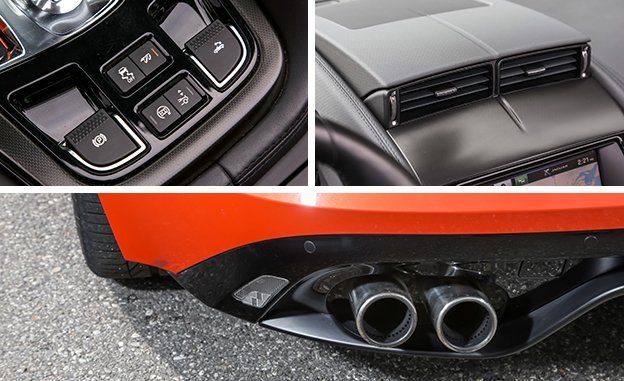
 Top right: The motorized center HVAC vent unit is a nice theatrical touch, but no one was surprised when it stopped working. Bottom: The F-type is not the world's loudest car at wide-open throttle, but it grumbles and pops on overrun more antisocially than the rest.
Top right: The motorized center HVAC vent unit is a nice theatrical touch, but no one was surprised when it stopped working. Bottom: The F-type is not the world's loudest car at wide-open throttle, but it grumbles and pops on overrun more antisocially than the rest.
In California, the Jaguar’s service indicator finally demanded the first oil change, the odometer showing an astonishing 16,000 miles. Clearly, Jaguar doesn’t believe in the 3000-mile oil change, even on a 495-hp performance car. Our second visit at twice that mileage cost $185 for an oil-and-filter swap, so this is a pretty cheap car to keep lubed to factory spec. Assuming, of course, the service minder is working properly (the handbook confirmed the long service intervals).
Out-of-pocket repair expenses were largely restricted to wheels and tires, with the emphasis on “large.” Besides the two winter tires we replaced, the two rear summer tires wore out at 25,000 miles, costing us a further $832 for a new pair. While all this tire swapping was going on, we discovered two damaged rims, one cracked and one bent, at least one of these issues possibly due to the long drive on the flat in Colorado. That cost us $1876 for replacements.
Not counting fuel, it cost us more than $4000 to keep our F-type on the road through the 40,000-mile test. While much of this went to pothole-related damage, it speaks to the potentially high ancillary costs of driving an expensive sports car year-round. And the number of warranty repairs was not exactly reassuring when weighed against Jaguar’s suspect quality reputation.
But, as web editor Alexander Stoklosa commented, “Boy, that exhaust button cures many ills.” As the first new model to be released in the post-Ford era, the F-type is a welcome harbinger of things to come from a venerable marque. Consider this, then, a ringing endorsement for the ringing in our ears.
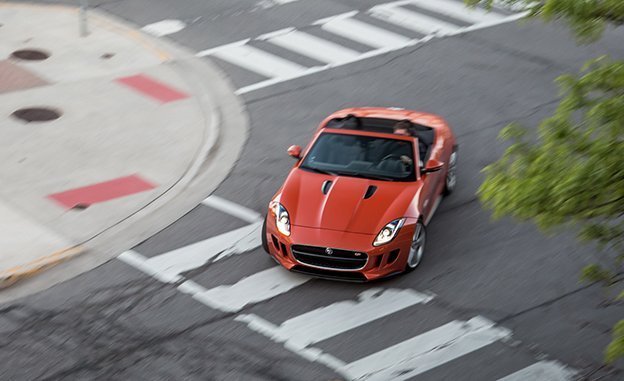

Jared Gall: I could write an epic love poem to this exhaust system. How many words do you get for a long-term wrap? I’ll need all 1200 and more.
Mike Sutton: What a wonderfully childish automobile. Great for waking up the neighbors and upsetting cyclists.
Aaron Robinson: My wife refuses to get in it. She says a car with square wheels would have a better ride.
David Beard: Aural fireworks on throttle liftoff almost started a shootout between the MS-13 and 18th Street gangs in South Central Los Angeles.
Clifford Atiyeh: Say what you want about the Corvette being cheaper and just as fast, but the F-type is the car you want to be seen in.
Kirk Seaman: Impossible to refuel without the filler nozzle clicking off. I’ve tried more positions than the Kama Sutra.
Rusty Blackwell: The backup camera, mounted so low on the car, would be good for finding lost items beneath one’s couch.
K.C. Colwell: Top up, rearward visibility is horrible. Changing lanes is a total crapshoot. You might as well put a bag on your head before you turn to check the left flank.
Jared Gall: Seriously, I know I’ve written about it before, but the exhaust on this car sounds so good that there’s no point in talking about any other aspect.